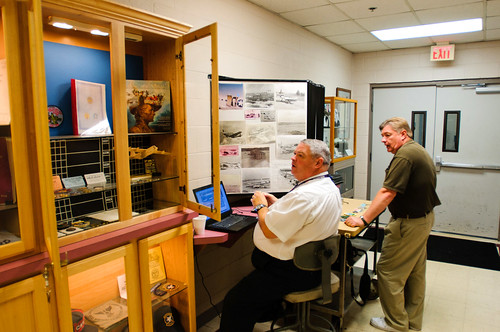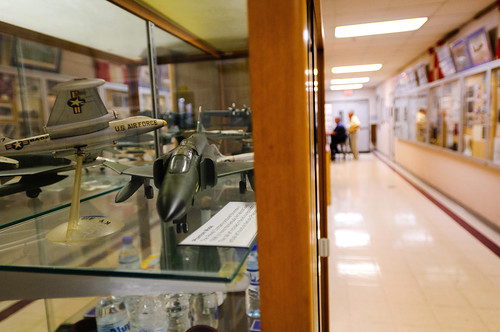Story by Master Sgt. Phil Speck, 123rd Airlift Wing Public Affairs
View more photos click here
[caption id="" align="alignleft" width="210" caption="Kentucky National Guard command historian John Trowbridge (left) and Tom Fugate, a former curator at the Kentucky Military History Museum in Frankfort, Ky., catalog Kentucky Air National Guard memorabilia at the Air Guard Base in Louisville Ky., Oct. 6.(U.S. Air Force photo by Master Sgt. Phil Speck)"]
 KENTUCKY AIR NATIONAL GUARD BASE, LOUISVILLE, Ky.
KENTUCKY AIR NATIONAL GUARD BASE, LOUISVILLE, Ky. — Historians have begun cataloging the Kentucky Air National Guard’s vast treasure trove of military artifacts in preparation for a 2013 exhibit of memorabilia at the Frazier History Museum.
The items, which range from old photographs and uniform patches to an oxygen mask and pilot’s helmet, are currently displayed in Heritage Hall, a mini-museum that lines the hallways of the 123
rd Airlift Wing Maintenance Hangar here. Heritage Hall was created by retired Chief Master Sgt. Kenny Coogle and is currently maintained by Master Sgt. John Wardrip. It features cabinets built by retired Lt. Col. Paul Stone and retired Chief Master Sgt. Billy Milburn.
Those cabinets contain many one-dimensional items like newspaper clippings and other documents, but the items that really shine are the three-dimensional artifacts such as flags, coins, models and equipment, said John Trowbridge, Kentucky National Guard command historian.
One such item is the helmet of former base detachment commander Lt. Col. Lee J. Merkel, who died during a test flight when his F-51 Mustang crashed near Bedford, Ind., on Jan. 31, 1956. Prior to joining the Kentucky Air Guard, Merkel was a highly decorated World War II pilot who saw service in North Africa and Europe before being shot down behind enemy lines in Italy.
“There are some very unique artifacts here,” said Trowbridge, one of two historians carrying out the cataloging survey. “How many places can you see the helmet that Colonel Merkel was wearing when he died in that crash? If Chief Coogle hadn’t taken the initiative and saw that history needed to be preserved, we may not have had any of this to see today.
“This is the single largest collection of Kentucky Air Guard artifacts anywhere, and it tells the complete story of the Kentucky Air National Guard.”
The cataloging process is the first step toward professionally managing the historical collection, said Tom Fugate, a cultural historian and former curator at the Kentucky Military History Museum in Frankfort, Ky. Fugate is assisting with the effort, which both historians estimate will take about two months.
[caption id="" align="alignright" width="300" caption="A mini-museum of artifacts at the Kentucky Air National Guard Base in Louisville, Ky., features hundreds of items representing the unit’s history, from photographs and patches to helmets and flags. The museum was created by retired Chief Master Sgt. Kenny Coogle. (U.S. Air Force photo by Master Sgt. Phil Speck)"]

Fugate and Trowbridge are cataloging the artifacts with the help of a computer program called PastPerfect, the industry-standard software for museum record-keeping. After being populated with items, it can generate printed booklets of all the memorabilia in a collection.
Cataloging these artifacts now will help the Frazier museum to design a compelling exhibit in 2013, Trowbridge said. If the museum wants a certain item such as a signal flag, they will be able to use the software to search for the item. The software will then track what has been loaned out, so it can be properly returned to its home in Heritage Hall at a later date.
The software also will also help curators at the Air Guard keep track of who originally provided artifacts for display in Heritage Hall, and whether those artifacts are on temporary loan or were donated to the Kentucky Air Guard’s permanent collection.
Trowbridge described this stewardship as an important responsibility.
“You have to document what you have here, so you don’t lose accountability of these artifacts that have been entrusted to you to preserve to tell the history of the organization,” he said. “You’re saying, ‘We accept this, and we’re going to protect this forever.’ ”
Fugate echoed those sentiments.
“The goal of the guys here in the unit is to preserve what they have and make sure they are properly caring for it so it will last into the next generation,” he said. “Without accountability for the material we have on hand, we cannot ensure for the next generation that this material will survive.”
View more photos click here.